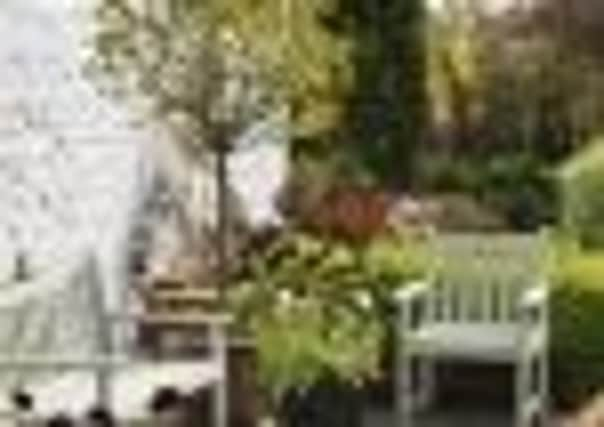Gardens: Joan Goldie is a self-taught gardener whose wisdom – as much as her planting – is highly valued by the constant stream of visitors to her East Ayrshire farmhouse


It is this sort of generosity that prompted a farmer’s wife to share the plants she has spent years growing.
Joan Goldie moved to the farm in East Ayrshire 49 years ago, when she married Jim, a dairy farmer. Joan began cultivating the area around their house. She grew up during wartime, when everyone who could be was a gardener, and she picked up a bit of knowledge along the way.
Advertisement
Hide AdAdvertisement
Hide AdShe planted anything she could get her hands on. Some were things family and friends passed on to her. “When you have young family you don’t have the money to spend on plants,” Joan says, but she gradually built up what was there, swapping plants with other gardeners and occasionally buying some. Next to the house was a croquet lawn. It stayed until the couple’s children went to university, then it came up bit by bit. “Everywhere Jim had a veg plot, when the veg came out I would put plants in.” The cultivated garden grew outwards from the house, spreading around the dairy sheds.
The couple retired ten years ago. The garden had become known by word of mouth as a lovely place to visit, stuffed full of herbaceous plants – in effect a private nursery. “The way I started selling plants was that visitors from gardening clubs would come and they wanted to buy some of the plants,” says Joan. From spring, she takes divisions and seeds from her stock and grows them on. Her days are spent in the garden propagating her specimens. By summer, rows of pots are lined up, and when visitors come to enjoy the deep herbaceous borders they can buy plants to take home.
A small percentage of Joan’s plants have breeders’ rights, meaning she has to buy these plants in order to be able to sell them, rather than dividing them herself. “It’s a sort of royalty charge,” she says, but the remaining 95 per cent of everything that is for sale comes from her own plants.
Aside from the lawn, which is cared for by a friend, the garden is given over to herbaceous borders – no mean feat, given that the soil is heavy clay. Some plants, such as rodgersia, love a damp, clay soil. But Joan has improved hers with fertiliser and manages to grow a huge variety of species, some of which might not otherwise have been so happy. There was a lime works at Lugton and the farm sat on lime, so acid-loving rhododendrons, azaleas and some lilies will not grow. But there are a smattering of others that could easily object to having cold feet, such as meconopsis. What plants she can’t grow prolifically are compensated in others – 15 varieties of dicentra, about 50 hostas and 20 different kinds of campanulas, for example.
Her favourites are dicentra, trilliums, delphiniums, thalictrums and astrantias. Those that do best are the “toughies”, especially plants that like rain. But the abundance of aquilegias, poppies and high-summer sizzlers like kniphophia and crocosmia give a warm, soft and welcoming cottage-garden feel.
A path leads from farmhouse to barn to field and to views beyond, connecting visitors with the land in all its beauty and utility. The bottom of the garden has been given over to introducing the Goldies’ grand-daughters to gardening, and two of them are currently in competition to grow the tallest sunflower. The farmhouse is constantly busy with family and friends, each enjoying the casual feel of the garden’s pleasure and purpose. “It’s like this all the time,” says Joan as she welcomes visitors and family, all jostling for attention. And it’s a bit like that with the plants. Borders of cottage-garden plants encircle the house, patchworked with plant stands and plots for vegetables such as broccoli, peas, leeks, carrots, beetroot and kale.
A lot of thought has gone into the planting scheme. Joan chose the ornamental Stipa gigantea, or giant feather grass, because it is more subtle than huge pampas grasses. Other plants have interesting foliage, such as the big-leaved Astilboides tabularis, next to a variegated astrantia. No space is wasted: a cherry tree’s base is encircled by the candy pink heads of persicaria, and banks are scattered with poppies. There are shade-lovers such as mandrake, patches of candelabra primula, with heads like red and orange butterflies, geraniums, irises and red-leafed heucheras.
Joan also has several herbaceous clematis, unusual for a plant that is usually found as a shrub. Herbaceous plants of all heights are catered for, from meadow rue and flamboyant oriental poppies to thick clumps of the annual poached egg plant, which hums with honey bees. The taller plants that many gardeners avoid grow through special netting to give them support, which enables them to stay upright when heavy rain threatens to pull them over. Early summer brings another unusual flower, Roscoea cautleyoides, with its raggy pale yellow heads. It is the first of the ginger plants to flower – others’ leaves are only just emerging.
Advertisement
Hide AdAdvertisement
Hide AdJoan is self-taught in horticulture but is always ready to pass on some of her knowledge to visitors. It’s a very casual, friendly and low-key thing. “I’ve just collected plants for 49 years,” says Joan, “that’s the bottom line.”
•East Lugtonridge Farm is on Lochlibo Road, near Burnhouse